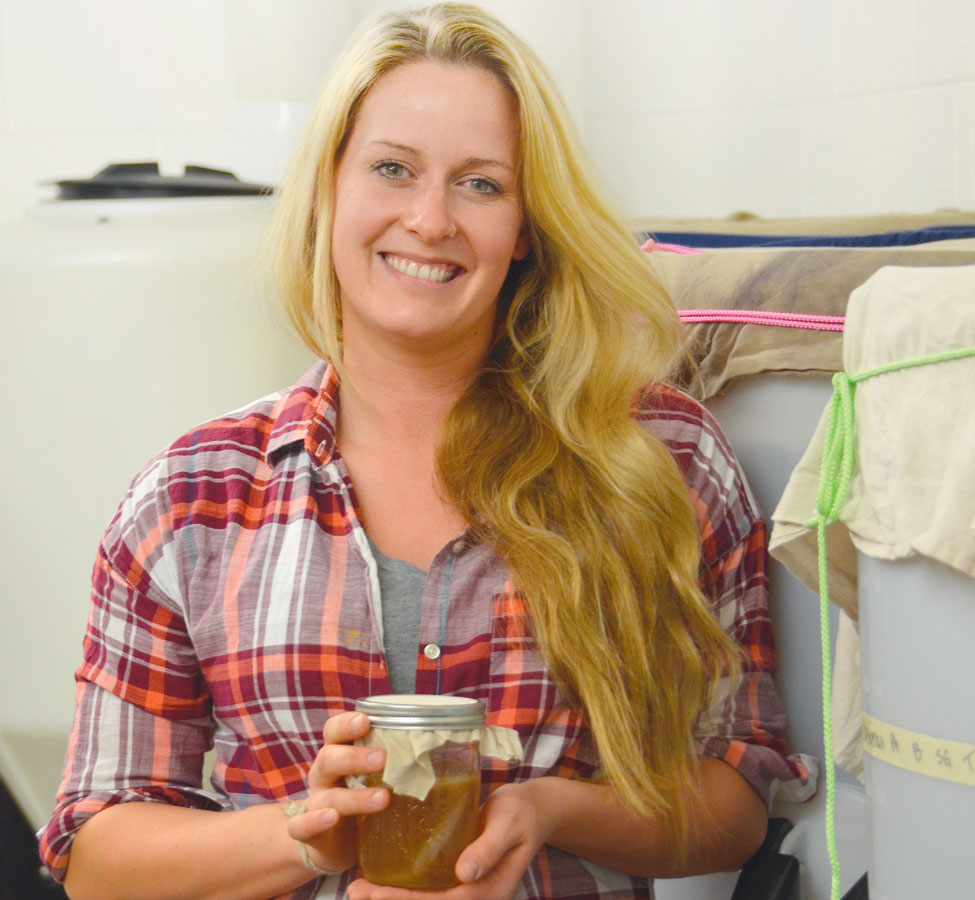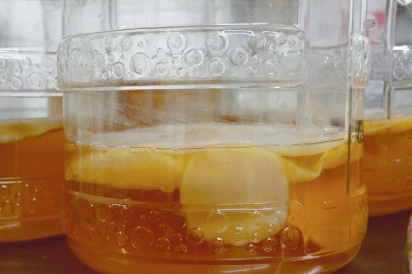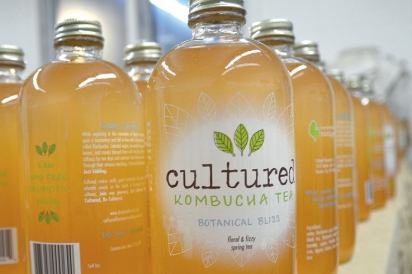The Cultured Pantry
Kombucha Tea: Brewing Up a Delicious, Nutritious, Effervescent Business
I am sitting with Courtney Lorenz, creator and prime mover and shaker of Cultured Ferments, in her small office adjacent to her fermenting room in the hub of the new Cherry Capital Foods building. She’s given me the only desk chair so I can take notes while she perches on a barrel as we chat about her whirlwind 18 months of business creating, fermenting, bottling and selling her line of fermented drinks, aka kombucha.
In no time at all I am in awe of this dynamic, energetic, focused, smart and accomplished woman, just 25 years old. I also find myself begging her to slow down as I type my notes as quickly as I might. There is so much there, so many ideas, so much passion.
First off, what is kombucha?
A good description: a lightly sweetened tea, be it black or green or herbal, fermented and often a little carbonated. To make it, a mother culture, called SCOBY (for Symbiotic Colony Of Bacteria and Yeast), is added to the tea base, initiating the fermentation. The culture breaks down sucrose to fructose and glucose, producing ethanol which itself becomes food to the bacteria. At a set point the liquid is minimally filtered and transferred to bottles and sealed, so the carbon dioxide produced by the fermentation activity cannot escape, but instead recombines with the liquid to produce carbonation.
Courtney traces kombucha’s origins to the Far East, be that in Mongolia, Russia or China. Fermentation is an ancient knowledge and the precise origin of this particular culture is uncertain. Etymologically, “-cha” means tea in both Japanese and Chinese. Wikipedia puts its origins in Manchuria around 220 BCE, imported to Japan around 400 CE by a physician named Kombu (this clears up a bit of confusion as to the word Kombu, which has a homonym meaning a specific type of seaweed). Interestingly, the Japanese call this beverage Kocha-kinoko, which literally means “dark tea mushroom.”
Courtney makes five flavors of her kombucha: Genuine Ginger, Namaste Nectar, Mind’s Eye Chai, Botanical Bliss (her newest) and Tangerine Tantra. And yes, she does like yoga, and did once think she’d go for a yoga teacher’s certificate, but a broken ankle has put that on hold for the time being.
All the ingredients used in her production are organic and quite a few are biodynamic. As many as possible are locally sourced. Personalizing the operation a few steps further, all the batches have names and have been given a positive word or phrase, such as Flourishing Fez. Courtney has read and integrated the power of positive thought and impression as related by the tests of the Japanese author/photographer Masaru Emoto.
FOOD FOR WELL-BEING
Courtney first moved to Traverse City from Grass Lake, Michigan, in 2009 to attend the Great Lakes Culinary Institute at NMC, graduating in 2011. From there she worked for farmers and bakers (9 Bean Rows in Suttons Bay), contemplated a further degree in nutrition, then shifted gears toward hospitality and entrepreneurship. A stint downstate at a large company as food and beverage director, however, cured her of “normal jobs.”
Leaving the stability of a salary and good benefits, she returned to Traverse City impassioned with a desire to help people connect to their food and recognize its role in their deeper health and well-being.
“I’ve grown food, prepared food and cooked food. I wanted to bring together all these aspects of my own education and communicate what the food does once it enters your body. I believe knowing how food interacts with you is super important. For most people there is not a big association between the final product and the origins of their food.
“Up here [in Traverse City] we have an extraordinarily well-educated and attuned population, close to our food sources, caring about them, aware. It’s the perfect place to reach out to people.”
ZEROING IN ON KOMBUCHA
Before deciding upon kombucha, Courtney started with the broader idea of a Cultured Culture: the health and wellness benefits of fermented foods. She felt that many people have a limited association of fermentation as having to do with wine and beer, but there is also sourdough bread, cheese, yogurt, kefir, sauerkraut and more.
“Having probiotics in your diet is essential to overall health and wellness. Fermentation [of kombucha] is all about balance. Balancing the sugars with the yeast. Balancing the fermentation time with the taste you want to create. [And] Internally you are balancing the bacteria in your body with the yeast.
“Kombucha is not a miraculous cure, however, it can help balance your body out. When your body is in balance, healing is supported.”
Courtney first started brewing kombucha for her own consumption. First she’d brew a gallon, then five gallons. But that was more than she could consume herself so she exchanged her kombucha for eggs from one friend, vegetables from another. The tipping point came somewhere between five and ten gallons a week. Suddenly, it looked like not only could she do something she loved, but she could potentially earn a living doing this.
With her background in culinary studies and hospitality management, she capably negotiated the demands of the local health department, and in May 2015 was open for business and able to attend the Sara Hardy Outdoor Market in downtown Traverse City. She is now producing 14 (55- gallon) tanks of kombucha approximately every 14 days.
IT’S ALIVE!
She laughingly details how much she has learned over the past two years. “As they say, don’t let your education get in the way of your learning. Being in business for yourself is great—and the different types of people that you meet. What you need to know, learn—plumbing, electricity—I’ve had to take crash courses in all of these and I’ve loved it all!”
Fermentation is the art of controlling live cultures, encouraging them to do as you wish. It is also a humbling and contrary master—moving quickly (as few as seven days) and becoming lively and fizzy in the summer; moving slowly (as many as 21 days) and producing less carbonation in the winter. You could almost adapt a certain proverb to: as difficult as shepherding yeast and bacteria strains. According to Courtney, there are over 500 in her kombucha.
“Of course I am for a certain level of consistency. But it is alive and changes with the seasons. I control what I can, but it will do what it wants to do in the long run. This is why some bottles are more fizzy than others. Even with a weather seal and climate control, the yeast and bacteria are very sensitive to the seasons.”
Cultured Ferments is continuing to expand, but not too fast. Those live cultures dictate how much they can ferment, and thus how many bottles can be sent to market. So, following a pace set by life, Courtney is set to continue her six-day work weeks, up every morning between 4:30 and 5, to the gym and then to work. Home by 6 to snuggle with her dog, perhaps set out for a bit of snowshoeing, and then to bed, ready to get up the next day to start doing it all over again.
This spring she hopes to hire a couple of employees, beyond herself and her market assistant, to bottle and label and to do social media and marketing. She will continue as head brewer and presence at the market, where she loves having direct contact with her clients.
“LIVING FOODS NOURISH”
Courtney believes we should all be eating more fermented foods. These are foods that are alive with active cultures, and “living foods nourish.” Eat what is alive. For some clients, her kombucha is a favorite substitute for morning coffee. For others, an afternoon pick-me-up. It warms an empty belly, preparing it for the act of digestion. It can both prepare the stomach for a meal, and help it conclude one.
There are many ways to incorporate kombucha into your life. Add it to your favorite fruits and blend into a smoothie. Or bring it out as a cocktail mixer. Courtney suggests her Genuine Ginger paired with vodka or whiskey for a unique Moscow Mule (1 ounce vodka to 4 ounces Genuine Ginger Kombucha, a splash of sweetened lime juice and a sprig of mint). Another variation might be a Kombucha Snake Bite—half kombucha and half cider.
To facilitate the possibility of our local-and Michigan-based breweries, bars and restaurants offering such an option, Cultured Ferments now offers Genuine Ginger Kombucha on draft in kegs.
Look for her special Right Brain Brewery collaboration “Ginger Rye Saison” to come out on the brewery’s Collaboration Day, February 11, 2017.
You’ll find Courtney and her delectable brews this winter at the Indoor Farmers’ Market at the Commons in Traverse City. Be sure to stop by and visit. You’ll be delighted by the flavors, the possibilities and her infectious joy, just as I was.
FIND IT:
Cherry Capital Foods distributes Cultured Ferments to over 50 locations throughout Michigan, from Marquette to Detroit. In Traverse City find Cultured Ferments at Oryana Community Co-op, Edson Farms Natural Foods, Pleasanton Bakery, Cuppa Joe, Yen Yoga, Spanglish, Milk and Honey, The Peninsula Market, and Burritt’s Market and the Breakaway Cafe. In Petoskey at the Grain Train and Toski Sands. In Leelanau County at Anderson’s Market, Creation Farm Market, 9 Bean Rows, The Redheads Cafe and Leland Mercantile.







